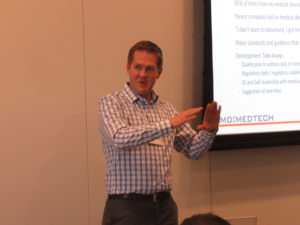
As noted in my previous blog post, I attended and presented at the INCOSE Conference on Agile in Healthcare last month. Here is my presentation. It was great to hear perspectives on being agile in healthcare product development, and discussing best practices with many thought leaders from major medical device manufacturers. I picked up two ideas that I’d like to investigate further and integrate into CMD’s processes as it makes sense.
First was the concept of agile practices in hardware development. While I don’t think a full-on scrum methodology makes sense for hardware (though it can be done with modified sprint cycles), I do appreciate the simplicity of a kanban-style backlog and project management process. In addition to kanban, I received some great insight on how to better integrate software and hardware development into sprint cycles.
Second, I’d like to investigate the SAFe agile framework further (P.S.: not an endorsement of SAFe). SAFe extends agile methodologies to the project and enterprise levels. A couple of medical device manufacturers with highly mature product development processes are using SAFe (or customized versions of it). It requires a good bit of tailoring to fit within a Quality Management System, but if done well, I think it has great potential for developing and maintaining a streamlined portfolio of safe and effective products.
